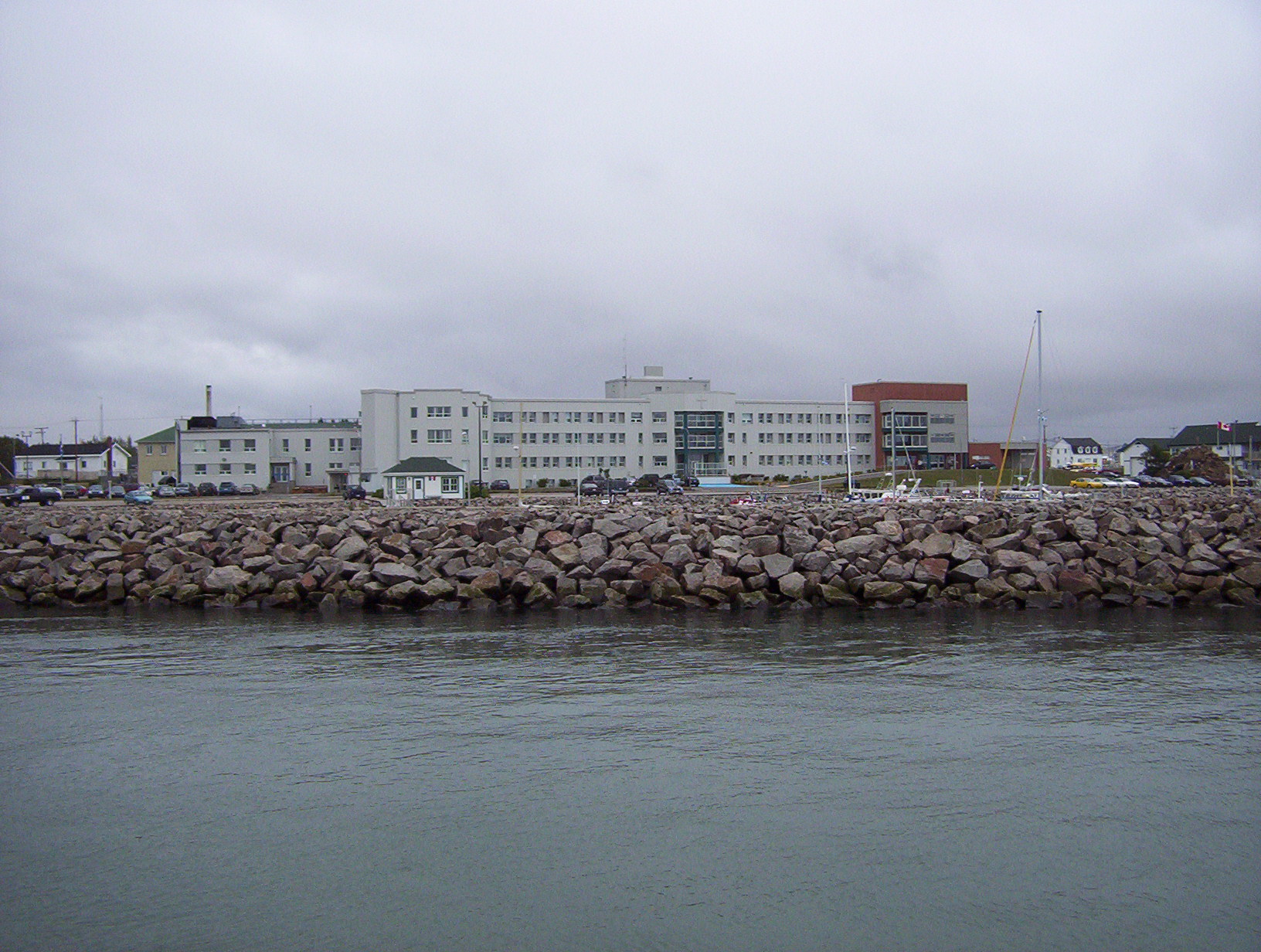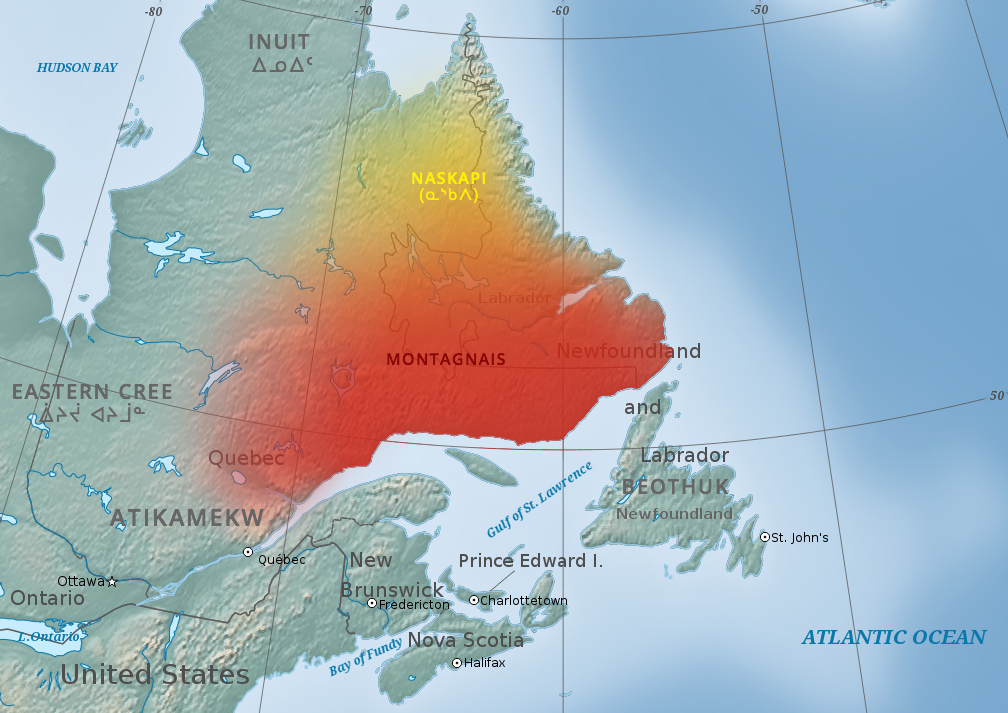|
Romaine-1 Generating Station
The Romaine-1 Generating Station (french: Centrale de la Romaine-1) is a 270 MW hydroelectric generating station on the Romaine River in the Côte-Nord region of the province of Quebec, Canada. It is owned and operated by Hydro-Québec. Location The dam is on the Romaine River in the municipality of Havre-Saint-Pierre in the Minganie Regional County Municipality, Quebec. It is from the mouth of the river. The site is open to visitors, who can visit three floors of the generating station and walk on the dam. Description The Romaine-1 Dam (''Barrage de la Romaine-1'') is high and has a holding capacity of . It is zoned rockfill, with a waterproofing screen. The foundation is treated rock. The reservoir covers . Peak surface elevation is . Drawdown from peak to minimum water levels is just . A short canal carries water from just west of the dam to the generating station's water intake. The plant does not have a feed gallery or a surge chamber. It has two Francis-type turbi ... [...More Info...] [...Related Items...] OR: [Wikipedia] [Google] [Baidu] |
Havre-Saint-Pierre
Havre-Saint-Pierre is a town on Pointe-aux-Esquimaux, which is on the Quebec north shore (Côte-Nord) of the Saint Lawrence River in Canada. Located along Route 138 some east of Sept-Îles, it is the largest town and seat of the Minganie RCM, and home to many government, municipal, and regional services. Historically, the town's first inhabitants came from the Magdalen Islands in the nineteenth century. As a result, the people of the town speak a dialect much more closely related to Acadian French than to Quebec French. Other important geological features near the town include the Romaine River to the north and west, les Chutes Manitou, on the Manitou River to the west, l'Ile du Havre, less than a kilometre offshore from the town, and Anticosti Island, which on clear days can be seen to the south of the town. History In 1857, a group of Acadian families from the Magdalen Islands, who had been deported from Savannah (Georgia, USA), settled on Eskimo Point (''Pointe aux Esqui ... [...More Info...] [...Related Items...] OR: [Wikipedia] [Google] [Baidu] |
Innu
The Innu / Ilnu ("man", "person") or Innut / Innuat / Ilnuatsh ("people"), formerly called Montagnais from the French colonial period ( French for "mountain people", English pronunciation: ), are the Indigenous inhabitants of territory in the northeastern portion of the present-day province of Labrador and some portions of Quebec. They refer to their traditional homeland as ''Nitassinan'' ("Our Land", ᓂᑕᔅᓯᓇᓐ) or ''Innu-assi'' ("Innu Land"). The Innu are divided into several bands, with the Montagnais being the southernmost group and the Naskapi being the northernmost. Their ancestors were known to have lived on these lands as hunter-gatherers for several thousand years. To support their seasonal hunting migrations, they created portable tents made of animal skins. Their subsistence activities were historically centred on hunting and trapping caribou, moose, deer, and small game. Their language, Ilnu-Aimun or Innu-Aimun (popularly known since the French colonia ... [...More Info...] [...Related Items...] OR: [Wikipedia] [Google] [Baidu] |
Minganie Regional County Municipality
Minganie is a regional county municipality in the Côte-Nord region of Quebec, Canada. It includes Anticosti Island. Its seat is Havre-Saint-Pierre, Quebec, Havre-Saint-Pierre. It has an area of according to Quebec's ''Ministère des Affaires municipales, des Régions et de l'Occupation du territoire'' (which includes coastal, lake, and river water territory and also Labrador boundary dispute, disputed land within Labrador), or a land area of according to Statistics Canada. The population from the Canada 2011 Census was 6,582 and in 2016 Canadian Census, 2016 it was 11,323. The majority live in Havre-Saint-Pierre. Minganie and the neighbouring Le Golfe-du-Saint-Laurent Regional County Municipality are grouped into the single Census divisions of Canada, census division of Minganie—Le Golfe-du-Saint-Laurent (known as Minganie–Basse-Côte-Nord before 2010). The combined population at the Canada 2011 Census was 11,708. Until 2002, Minganie RCM encompassed the entire lower n ... [...More Info...] [...Related Items...] OR: [Wikipedia] [Google] [Baidu] |
Dams In Quebec
A dam is a barrier that stops or restricts the flow of surface water or underground streams. Reservoirs created by dams not only suppress floods but also provide water for activities such as irrigation, human consumption, industrial use, aquaculture, and navigability. Hydropower is often used in conjunction with dams to generate electricity. A dam can also be used to collect or store water which can be evenly distributed between locations. Dams generally serve the primary purpose of retaining water, while other structures such as floodgates or levees (also known as dikes) are used to manage or prevent water flow into specific land regions. The earliest known dam is the Jawa Dam in Jordan, dating to 3,000 BC. The word ''dam'' can be traced back to Middle English, and before that, from Middle Dutch, as seen in the names of many old cities, such as Amsterdam and Rotterdam. History Ancient dams Early dam building took place in Mesopotamia and the Middle East. Dams were used ... [...More Info...] [...Related Items...] OR: [Wikipedia] [Google] [Baidu] |
Natashquan 1
Nutashkuan ( INAC) or Natashquan (CGNDB) (sometimes Natashquan 1) is a First Nations reserve in the Canadian province of Quebec, belonging to the Première Nation des Innus de Nutashkuan band. The reserve is located on the north shore of the Gulf of St. Lawrence at the mouth of the Natashquan River, east of Sept-Îles and has been accessible by Route 138 since 1996. The reserve should not be confused with the adjacent but distinct township of Natashquan just to the north and east. The community is serviced by a nursing station, community radio station, municipal water and sewer system, fire station, and an aboriginal police force. The site was mapped in 1684 by Louis Jolliet who called it ''Noutascoüan''. It was subsequently spelled as ''Nontascouanne'' (1734), ''Natasquan'' (1831), ''Nataskwan'' (1844), ''Natashkwan'' (1846), ''Natosquan'' (1857), ''Nataskouan'' (1858), and taking its current form, Natashquan, circa 1895. This name, spelled Nutahkuant or Nutashkuan in ... [...More Info...] [...Related Items...] OR: [Wikipedia] [Google] [Baidu] |
Pessamit
Pessamit (formerly Betsiamites, or Bersimis), is a First Nations reserve and Innu community in the Canadian province of Quebec, located about southwest from Baie-Comeau along the north shore of the Saint Lawrence River at the mouth of the Betsiamites River. It is across the river directly north of Rimouski, Quebec. It belongs to the Pessamit Innu Band. The reserve includes the communities of Betsiamites and Papinachois. Etymology It has been argued that the word Betsiamites could mean "those arriving by river". However, most authors today agree that the word came from the Innu root "Pessamit", meaning of "place where there are leeches or lampreys or sea eels". The dialect spoken at Mistissini uses the older form "upesciyâmîhc" as the locative noun referring to the town, and the form "upesciyâmîw-iyiniw" in reference to the people of Pessamit. The local form of the name can be explained by phonological changes that have occurred in the local dialect. In particular, the dialect ... [...More Info...] [...Related Items...] OR: [Wikipedia] [Google] [Baidu] |
Maliotenam
Maliotenam (Mani-Utenam in Innu-aimun) is a First Nations reserve in Quebec, located adjacent to the city of Sept-Îles, Quebec, Sept-Îles. Together with Uashat some distance away, it forms the Innu community of Uashat-Maliotenam. The community is a part of the Manicouagan district which is represented by Bloc Québécois MP Marilène Gill. The community has a population of approximately 1,600 people. The community share its administration with the nearby community of Uashat as the Innu Takuaikan Uashat Mak Mani-Utenam. The chief and council consists of the chief, deputy chief and five councillors. The chief and council are all elected by the members of the community Innu Takuaikan Uashat Mak Mani-Utenam. The current chief is Mike Pelash McKenzie, alongside Antoine (Maniteu) Grégoire as deputy chief. The current councillors are Jonathan St-Onge, Normand Ambroise, Dave Vollant, Kenny Régis, and Zachary Vollant. Maliotenam is enclaved within the city of Sept-Îles and is there ... [...More Info...] [...Related Items...] OR: [Wikipedia] [Google] [Baidu] |
Quebec Route 138
Route 138 is a major highway in the Canadian province of Quebec, following the entire north shore of the Saint Lawrence River past Montreal to the temporary eastern terminus in Kegashka on the Gulf of Saint Lawrence. The western terminus is in Elgin, at the border with New York State south-west of Montreal (connecting with New York State Route 30 at the Trout River Border Crossing). Part of this highway is known as the '' Chemin du Roy'', or King's Highway, which is one of the oldest highways in Canada. It passes through the Montérégie, Lanaudière, Mauricie, Capitale-Nationale and Côte-Nord regions of Quebec. In Montreal, Highway 138 runs via Sherbrooke Street, crosses the Pierre Le Gardeur Bridge to Charlemagne and remains a four-lane road until exiting Repentigny. This highway takes a more scenic route than the more direct Autoroute 40 between Montreal and Quebec City. It crosses the Saguenay River via a ferry which travels between Baie-Sainte-Catherine and Tadoussac ... [...More Info...] [...Related Items...] OR: [Wikipedia] [Google] [Baidu] |
Philippe Couillard
Philippe Couillard (; born June 26, 1957) is a Canadian business advisor and former neurosurgeon, university professor and politician who served as 31st premier of Quebec from 2014 to 2018. Between 2003 and 2008, he was Quebec's Minister of Health and Social Services in Jean Charest's Liberal government and was MNA for Mont-Royal until he resigned in 2008. In the 2014 election, Couillard moved to the riding of Roberval, where he resides. He was the leader of the Quebec Liberal Party from 2013 to 2018. He resigned as Liberal leader and MNA on October 4, 2018. Background and early life Couillard was born in Montreal, Quebec, the son of Canadian-born Joseph Alfred Jean Pierre Couillard de Lespinay and French-born Hélène Yvonne Pardé. He holds a medical degree and a certification in neurosurgery from the Université de Montréal. He was the head of the department of neurosurgery at Hôpital Saint-Luc from 1989 to 1992 and again at the Centre Hospitalier Universitaire de Sherb ... [...More Info...] [...Related Items...] OR: [Wikipedia] [Google] [Baidu] |
Hydro-Québec
Hydro-Québec is a public utility that manages the generation, transmission and distribution of electricity in the Canadian province of Quebec, as well as the export of power to portions of the Northeast United States. It was established by the Government of Quebec in 1944 from the expropriation of private firms. This was followed by massive investment in hydro-electric projects like the James Bay Project. Today, with 63 hydroelectric power stations, the combined output capacity is 37,370 megawatts. Extra power is exported from the province and Hydro-Québec supplies 10 per cent of New England's power requirements. Hydro-Québec is a Crown corporation (state-owned enterprise) based in Montreal. In 2018, it paid CAD$2.39 billion in dividends to its sole shareholder, the Government of Québec. Its residential power rates are among the lowest in North America. More than 40 percent of Canada’s water resources are in Québec and Hydro-Québec is the fourth largest hydropower produ ... [...More Info...] [...Related Items...] OR: [Wikipedia] [Google] [Baidu] |
Romaine-3 Generating Station
The Romaine-3 Generating Station (french: Centrale de la Romaine-3) is a 395 MW hydroelectric generating station on the Romaine River in the Côte-Nord region of the province of Quebec, Canada. It is owned and operated by Hydro-Québec. Description The dams and generating station are part of a huge hydroelectric complex with four dams that was launched in 2009 under the government of Jean Charest. At maximum level, the Romaine-3 reservoir area is . The drawdown level is . Surface altitude varies from . The main dam is the second highest in the Romaine complex after Romaine-2. There are two dams, both completed in 2017. The main retaining dam is high, with thalweg height of and length of . The holding capacity is . It is a rockfill dam with zoned core, built on treated rock. The smaller B3 dyke is west of the main dam and contains the spillway. It is high, with thalweg height and length of . The holding capacity is . It is a concrete gravity dam built on treated rock. ... [...More Info...] [...Related Items...] OR: [Wikipedia] [Google] [Baidu] |
Romaine-2 Generating Station
The Romaine-2 Generating Station (french: Centrale de la Romaine-2) is a 640 MW hydroelectric generating station on the Romaine River in the Côte-Nord region of the province of Quebec, Canada. It is owned and operated by Hydro-Québec. Description The Romaine-2 Dam is from the river mouth. It is in the unorganized territory of Lac-Jérôme in the Minganie Regional County Municipality. It is high, and has a holding capacity of . It is a concrete gravity dam on a foundation of treated rock. The reservoir area is . Drawdown from high to low water level is . The lower part of the Abbé Huard River now forms the northeast arm of the Romaine-2 reservoir. In addition to the main dam, which includes the spillway, the river is contained by dykes A2, B2 and C2 above the dam, and by dykes D2, E2 and F2 below the dam. Five of the dykes contain asphalt/concrete waterproof cores. The largest is high. The penstock leads from an intake structure just north of Dyke D2 in a southeast ... [...More Info...] [...Related Items...] OR: [Wikipedia] [Google] [Baidu] |





